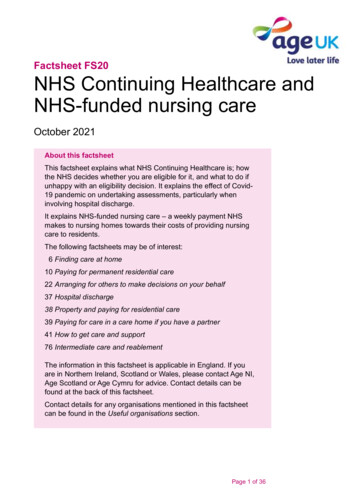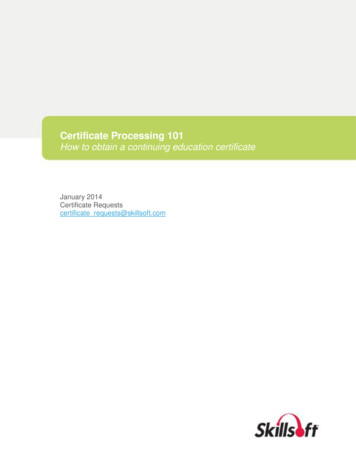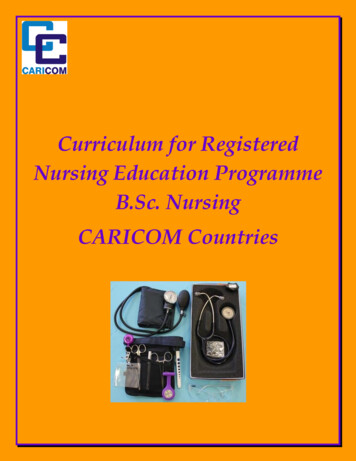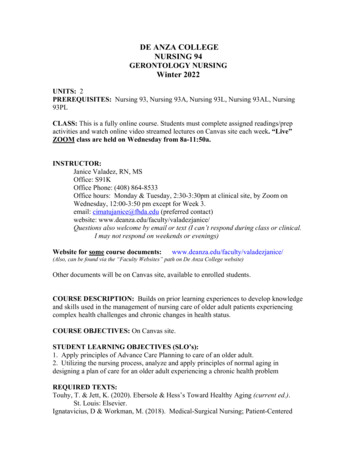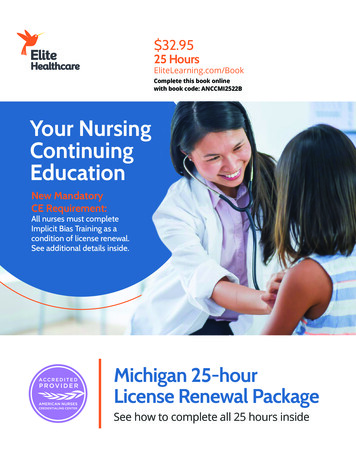
Transcription
32.95 25 HoursEliteLearning.com/BookComplete this book onlinewith book code: ANCCMI2522BYour NursingContinuingEducationNew MandatoryCE Requirement:All nurses must completeImplicit Bias Training as acondition of license renewal.See additional details inside.Michigan 25-hourLicense Renewal PackageSee how to complete all 25 hours inside
NEW MANDATORY CE REQUIREMENT FORMICHIGAN LICENSE RENEWALMichigan legislators have added an additional CE requirement for licensed nurses effective 6/1/2022. Inaddition to the existing 25 hours needed for license renewal, nurses must complete a 1-hour training exploringthe existence and effects of implicit bias in healthcare. The new requirement can only be completed vialive or online interactive methods. Training on implicit bias is required as a condition for initial licensure orregistration, as well as license or registration renewal and must be completed each renewal cycle.Elite is proud to offer a new webinar course that meets this 1-hour requirement:Michigan Implicit Bias Training for Healthcare Professionals.Important Note: This training is in addition to any continuing education required for license renewal.ABOUT THE TRAININGThis interactive 1-hour webinar course provides a historical context of race and its relationship to thedevelopment of racial implicit bias.The webinar is lead by Dr. Benjamin D. Reese, Jr., PsyD. Dr. Reese is a clinical psychologist and president ofBenReese, LLC, a North Carolina-based global diversity, equity, and inclusion consulting firm. He earned adoctorate in clinical psychology from the Rutgers University, Graduate School of Applied and ProfessionalPsychology. He has more than 50 years’ experience in the fields of implicit bias, systemic and structuralracism, and diversity, equity, and inclusion strategy.COMPLETE YOURREQUIREMENT VIAWEBINARStarting in March, Elite willoffer recurring webinars thatmeet this 1-hour requirement.The recurring webinars willbe held at least twice a monthuntil the end of 2022. The webinar will includeself-assessments to gauge your knowledgeand provide the opportunity to interact withthe presenter. A certificate of completion willbe awarded based on attestation, but there isno final exam. Scan the QR code to register forupcoming webinars. You can also find a full listof webinar dates and times atEliteLearning.com/MI-IBUPCOMING WEBINARS†Michigan Implicit Bias Training forHealthcare Professionals - 1 Contact HourTuesday, April 5th10am - 11am ETThursday, April 7th11am - 12pm ETTuesday, April 19th10am - 11am ETThursday, April 21st11am - 12pm ETTuesday, May 10th10am - 11am ETWednesday, May 11th11am - 12pm ETTuesday, May 17th10am - 11am ETThursday, May 19th11am - 12pm ETTuesday, May 31st10am - 11am ET* These dates and times are subject to change.† Schedule provided at time of printing.IMPORTANT NOTE!If you complete this book, you’ll receive an emailed discount codefor the Implicit Bias Training webinar course.Be sure to provide your email when completing this book.iNURSING CONTINUING EDUCATION
WHAT’S INSIDEPain Assessment and Management for Michigan Nurses (Mandatory)[2 contact hours]This course provides nurses with an overview of the physiology of pain and differentiates between acute and chronicpain. The course focuses on assessment and pharmacologic and non-pharmacologic treatment modalities for thepatient experiencing pain.1Documentation in the Electronic Age for Nurses15Fundamentals of Mentorship30Mindfulness for Healthcare Professionals44Population Health: Contemporary Perspectives for Nurses60Staying Healthy: Vaccine Preventable Diseases79[3 contact hours]The purpose of this course is to identify various methodologies of electronic nursing documentation, exploredependency on standardized nomenclature to provide trending and analyzable data and outcomes for both thepatient population and healthcare at large, as well as future innovations.[3 contact hours]This course explores the fundamentals of mentorship, offering insight into a phenomenon that supports andstrengthens our development as professionals, motivates us to expand our capacities, and inspires us to reach ouraspirations – in other words, to help us do all that we can.[3 contact hours]Building mindfulness-based, stress-reduction principles and techniques into healthcare environments can increasepositivity, safety, and pleasure in work. This course provides healthcare professionals with the knowledge to expandtheir understanding of what mindfulness is in its many forms. These include formal, structured approaches as variousapproaches to meditation, as well as informal, beneficial daily habits of thinking and behavior. The course explores theevidence base for the uses and benefits of mindfulness and presents ways to immediately apply these practices todaily personal and professional life.[4 contact hours]This course will provide current and relevant information about population health as it applies to contemporarynursing practice. The course presents an overview of population health via definitions and practical applications. It willdiscuss public health nurse standards of practice and the skills and knowledge that clinicians need in order to addressmodern day health issues, along with methods and strategies for tackling such health problems. Throughout thecourse, case examples will illustrate how to employ a population health approach to improve outcomes, not merely forindividuals, but for populations.[10 contact hours]The purpose of this course is to provide nurses with information that will enhance their knowledge of vaccine preventablediseases and how to work with patients and families to reduce the threat of acquiring such diseases.Course Participant Sheet130 2022: All Rights Reserved. Materials may not be reproduced without the expressed written permission or consent of Elite Professional Education, LLC.The materials presented in this course are meant to provide the consumer with general information on the topics covered. The information providedwas prepared by professionals with practical knowledge in the areas covered. It is not meant to provide medical, legal or professional services advice.Elite Professional Education, LLC recommends that you consult a medical, legal or professional services expert licensed in your state. Elite ProfessionalEducation, LLC has made all reasonable efforts to ensure that all content provided in this course is accurate and up to date at the time of printing, but doesnot represent or warrant that it will apply to your situation or circumstances and assumes no liability from reliance on these materials.iiNURSING CONTINUING EDUCATION
FREQUENTLY ASKED QUESTIONSWhat are the requirements for license renewal?Licenses ExpireContact HoursMandatory SubjectsPain and Symptom Management 2 contact hours required each renewal.Licenses expire every two yearsfrom date of initial licensure.25 (All hours are allowedthrough home-study)Human Trafficking - A one-time requirement.Implicit Bias - Effective 6/1/2022, training on implicit bias isrequired as a condition for initial licensure or registration aswell as license and registration renewal. Implicit bias trainingwill be required every license or registration renewal.How much will it cost?Course TitleContact HoursPricePain Assessment and Management for Michigan Nurses (Mandatory)Documentation in the Electronic Age for NursesFundamentals of MentorshipMindfulness for Healthcare ProfessionalsPopulation Health: Contemporary Perspectives for NursesStaying Healthy: Vaccine Preventable DiseasesBest Value - Save 131.75 - All 25 Hours233341025 20.95 23.95 23.95 23.95 26.95 44.95 32.95How do I complete this course andreceive my certificate of completion? re you a Michigan board-approvedAprovider? re my credit hours reported to theAMichigan board?What information do I need toprovide for course completion andcertificate issuance?Is my information secure? Important information for licensees:See the following page for step by stepinstructions to complete and receiveyour certificate.Please provide your license number onthe test sheet to receive course credit.Your state may require additionalinformation such as date of birth and/or last 4 of Social Security number;please provide these, if applicable.Yes, Elite is accredited as a providerof nursing continuing professionaldevelopment by the American NursesCredentialing Center’s Commissionon Accreditation. Michigan acceptscourses offered by an ANCC provider.Yes! We use SSL encryption, and wenever share your information withthird-parties. We are also rated A by the National Better BusinessBureau.No. The board performs randomaudits at which time proof ofcontinuing education must beprovided.Always check your state’s boardwebsite to determine the numberof hours required for renewal,mandatory subjects (as these aresubject to change), and the amountthat may be completed throughhome-study. Also, make sure that younotify the board of any changes ofaddress. It is important that your mostcurrent address is on file.Do you offer the Human Trafficking required course?Yes, it is available online at EliteLearning.com/MIWhat if I still have questions? What are your business hours?No problem, we have several options for you to choose from! Online at EliteLearning.com/Nursing you will see our robustFAQ section that answers many of your questions, simply click FAQs at the top of the page, e-mail us at office@elitelearning.com, or call us toll free at 1-866-344-0971, Monday - Friday 9:00 am - 6:00 pm, EST. Licensing board contact information:Michigan Board of Nursing I Department of Licensing and Regulatory AffairsBureau of Professional Licensing I Health Professions Licensing DivisionPO Box 30670 I Lansing, Michigan 48909 I Phone (517) 335-1980 I Website: https://www.michigan.gov/laraNURSING CONTINUING EDUCATIONiii
How to complete continuing educationPlease read these instructions before proceeding.Read and study the enclosed courses and complete the self-assessment exercises. To receive credit foryour courses, you must provide your customer information and complete the mandatory evaluation. Weoffer four ways for you to complete. Choose an option below to receive credit and your certificates ofcompletion.Fastest way to receive your certificateOnline Go to EliteLearning.com/Book. Use thebook code ANCCMI2522B and enter it inthe example box then click GO. If you already have an account created,sign in to your account with yourusername and password. If you do nothave an account already created, youwill need to create one now. Follow the online instructions to affirmcompletion of your course. Completethe purchase process to receive coursecredit and your certificate of completion.Please remember to complete theonline survey.Mobile Read and study all course materials.Text MIEVAL to 386-245-9322, then follow the link tocomplete affirmations.Use the book code ANCCMI2522B and enter it in theexample box then click GO.After completing affirmations, follow the link to getyour certificate.Per ANCC regulations, it is mandatory to complete a course evaluationfor each course taken.By mail Fill out the answer sheet and evaluation found in theback of this booklet. Please include a check or creditcard information and e-mail address. Mail to Elite,PO Box 37, Ormond Beach, FL 32175. Completions will be processed within 2 businessdays from the date it is received and certificates willbe e-mailed to the address provided. Submissions without a valid e-mail will be mailedto the address provided.By fax Fill out the answer sheet and evaluation found inthe back of this booklet. Please include credit cardinformation and e-mail address. Fax to(386) 673-3563. All completions will be processed within 2 businessdays of receipt and certificates e-mailed to theaddress provided. Submissions without a valid e-mail will be mailed tothe address provided.ivBook Code: ANCCMI2522B NURSING CONTINUING EDUCATION
Pain Assessment and Management for Michigan Nurses (Mandatory)2 Contact HoursRelease Date: March 7, 2020Expiration Date: March 7, 2023FacultyAnn M. Schreier, PhD, RN, received her baccalaureatedegree in nursing from Boston University, an MSN fromUniversity of California, San Francisco, and her PhD fromStanford University. Currently Dr. Schreier is a professor atEast Carolina University, College of Nursing in the NursingScience Department. She is a past president of the AmericanSociety of Pain Management Nursing.Ann M. Schreier has disclosed that she has no significantfinancial or other conflicts of interest pertaining to thiscourse.Peer reviewer:Susan L. Rubin, MSN, RN, received her baccalaureate degreein nursing from West Chester University and a master’sdegree in clinical trials nursing from Drexel University. She isa published author who has experience as a progressive careunit nurse with a special interest in cardiac nursing.Susan L. Rubin has disclosed that she has no significantfinancial or other conflicts of interest pertaining to thiscourse.Course overviewThe following program will provide nurses with an overviewof the physiology of pain and will differentiate betweenacute and chronic pain. The focus of the program willbe on assessment, as well as on pharmacologic andnonpharmacologic treatment modalities for the patientexperiencing pain.Learning objectivesAfter completing this course, the learner will be able to: Recall the definition, the nature, the impact, and theexpression of pain. Differentiate between nociceptive and neuropathic pain. Discuss the physiology of pain. Choose the appropriate pain assessment tool forindividual clients based upon cognitive abilities. Demonstrate an understanding of various treatments foracute and chronic pain, including pharmacological andnonpharmacological treatment modalities.Discuss the special considerations for pain management inpopulations such as the elderly, pediatric, and those whoare addicts or at risk for addiction.Select appropriate educational information for patientsregarding pain management.Discuss barriers to adequate treatment of pain.How to receive credit Read the entire course online or in print which requires a2-hour commitment of time. Complete the self-assessment quiz questions which are atthe end of the course or integrated throughout the course.These questions are NOT GRADED. The correct answeris shown after you answer the question. If the incorrectanswer is selected, the rationale for the correct answer isprovided. These questions help to affirm what you havelearned from the course. Depending on your state requirements you will be askedto complete either:An affirmation that you have completed theeducational activity. A mandatory test (a passing score of 70 percent isrequired). Test questions link content to learningobjectives as a method to enhance individualizedlearning and material retention. If requested, provide required personal information andpayment information. Complete the MANDATORY Course Evaluation. Print your Certificate of Completion. CE Broker reportingElite, provider # 50-4007, reports course completion resultswithin 1 business day to CE Broker. If you are licensed inArkansas, District of Columbia, Florida, Georgia, Kentucky,Mississippi, New Mexico, North Dakota, South Carolina, orWest Virginia, your successful completion results will beautomatically reported for you.Accreditations and approvalsElite is accredited as a provider of nursing continuingprofessional development by the American NursesCredentialing Center’s Commission on Accreditation.Individual state nursing approvalsIn addition to states that accept ANCC, Elite is an approvedprovider of continuing education in nursing by: Alabama,Provider #ABNP1418 (valid through February 5, 2025);California Board of Registered Nursing, Provider #CEP17480(valid through January 31, 2024); California Board ofVocational Nursing and Psychiatric Technicians (LVN Provider#15058, PT Provider #15020) valid through December 31,2023; District of Columbia Board of Nursing, Provider #504007; Florida Board of Nursing, Provider #50-4007; GeorgiaBoard of Nursing, Provider #50-4007; Kentucky Board ofNursing, Provider #7-0076 (valid through December 31, 2023);Mississippi Board of Nursing, Provider #50-4007; and NorthDakota Board of Nursing, Provider #50-4007. This CE programsatisfies the Massachusetts Board’s regulatory requirementsas defined in 244 CMR 5.00: Continuing Education.EliteLearning.com/NursingBook Code: ANCCMI2522BPage 1
Activity directorJune D. Thompson, DrPH, MSN, RN, FAEN, Lead Nurse PlannerDisclosuresResolution of conflict of interestIn accordance with the ANCC Standards for CommercialSupport for continuing education, Elite implementedmechanisms prior to the planning and implementation of thecontinuing education activity, to identify and resolve conflictsof interest for all individuals in a position to control content ofthe course activity.Sponsorship/commercial support and non-endorsementIt is the policy of Elite not to accept commercial support.Furthermore, commercial interests are prohibited fromdistributing or providing access to this activity to learners.DisclaimerThe information provided in this activity is for continuingrelative to diagnostic and treatment options of a specificeducation purposes only and is not meant to substitute forpatient’s medical condition.the independent medical judgment of a healthcare provider 2022: All Rights Reserved. Materials may not be reproduced without the expressed written permission or consent of EliteProfessional Education, LLC. The materials presented in this course are meant to provide the consumer with general informationon the topics covered. The information provided was prepared by professionals with practical knowledge of the areas covered.It is not meant to provide medical, legal, or professional advice. Elite Professional Education, LLC recommends that you consulta medical, legal, or professional services expert licensed in your state. Elite Professional Education, LLC has made all reasonableefforts to ensure that all content provided in this course is accurate and up to date at the time of printing, but does not representor warrant that it will apply to your situation nor circumstances and assumes no liability from reliance on these materials. Quotesare collected from customer feedback surveys. The models are intended to be representative and not actual customers.Course verificationAll individuals involved have disclosed that they have nosignificant financial or other conflicts of interest pertainingto this course. Likewise, and in compliance with CaliforniaAssembly Bill No. 241, every reasonable effort has been madeto ensure that the content in this course is balanced andunbiased.INTRODUCTIONPain affects millions of people worldwide, and 1 in 5 personsexperience chronic pain (International Association for theStudy of Pain [IASP], 2020). In the United States, high-impactchronic pain (pain that interferes significantly with physicalfunction) is experienced by over 19 million individuals.Pain is defined as an “unpleasant sensory and emotionalexperience associated with actual or potential tissue damageor described in terms of such damage” (IASP, 2020). Paincan be acute (lasting less than three to six months) orchronic (persisting more than three months) (World HealthOrganization [WHO], 2019). In the United States, pain isviewed as a public health crisis and has an impact on thephysical, psychological and social aspects of individualsexperiencing pain (United States Department of Healthand Human Services [USDHHS] National Inter-Agency TaskForce Report, 2019). Each individual’s response to pain isunique and is influenced by biological factors (comorbidities,physiological stress, genetics, and cognition), psychologicaland emotional factors (anxiety, fear, depression), and socialfactors (cultural/familial attitudes toward pain) and previousexperiences of pain (Ireland & Lalkhen, 2019).PrevalenceThe prevalence of pain can be difficult to accurately assessdue to the availability of data. Using data from a subsampleof National Health Interview Survey, 33% of adults withoutcancer reported at least one painful medical diagnosis (Nahinet al., 2019). This data excludes individuals without a medicaldiagnosis who may experience painful conditions and thosewith cancer who are experiencing pain. Because of barriers tohealthcare access and other factors such as reluctance to seekcare, pain prevalence is likely higher (Cooney et al., 2018).In general, women, older individuals, high school educatedindividuals and non-Hispanics were more likely to report apainful medical diagnosis (Nahin et al., 2019).In the United States, it is reported that 50 million (20.4%)adults experience chronic pain and 19 million (8%) have highimpact (severely limits activity) chronic pain. (Dahlhamer et al.,2018). A recent study of Medicare and Medicaid populationsidentified the three most common pain diagnoses as backpain (74%), degenerative spine disease (64%), and neuritis/radiculitis (53%), with many of this population experiencingmore than one pain diagnosis (Murphy et al., 2017). Pain ismore prevalent in the aging population. The prevalence ofpain ranges between 45% to 70% in frail older adults (Reyeset al., 2019). The high incidence of pain requires that healthcare workers be informed of the latest and best approachesto pain assessment, treatment, and management to achievethe best outcome.Financial impactThe financial impact of pain is burdensome, with billions ofdollars lost directly (through treatment or caregiving) andindirectly (through lost wages or productivity). It is estimatedthat the total costs associated with those experiencing pain isup to 635 billion annually (Murphy et al., 2017). The misuseof opioid pain prescriptions alone in the United States carriesan economic burden of 78.5 billion a year, which includescosts of health care, lost productivity, addiction treatment,and criminal justice involvement (Florence et al., 2016).Page 2Book Code: ANCCMI2522BEliteLearning.com/Nursing
PHYSIOLOGIC & PATHOLOGIC PAINPain can be considered physiologic or pathologic. Physiologicpain describes the type of pain that occurs when tissue isinjured; its function is to prevent further injury and promotesurvival. The injured person develops a memory in responseto the pain and will avoid being injured in the same fashion(for example: a small child getting burned by the stove willremember not to touch a hot stove in the future). Physiologicpain is often associated with acute, short-lived pain.Neuropathologic pain can also start with an injury to tissuebut eventually changes occur in the peripheral and centralnervous system along somatosensory pathways fromperiphery to cortex (Clauw et al., 2019). These changes donot serve a known purpose and are thought to be the causeof chronic (long-lasting) pain conditions, such as neuropathicpain and fibromyalgia (Clauw et al., 2019).NOCICEPTIVE PAIN AND NEUROPATHIC PAINThere are two main subtypes of pain: nociceptive pain andneuropathic pain.Nociceptive pain is the perception of noxious stimuli usuallycaused by tissue damage. It can further be categorized intosomatic or visceral pain (Rosenquist, 2017). Somatic painresults from tissue injury that occurs in the skin, as well as deeptissue such as fascia, tendons, and bone, and can be describedas sharp, then burning or throbbing, and is easily localized(Montgomery et al., 2018). Visceral pain originates in theviscera, usually in internal organs, and is mediated by stretchreceptors that allow a poorly localized, deep, and dull sensation(Montgomery et al., 2018). Common stimulators of theseafferent nerves are compression, inflammation, ischemia, orinfiltration by tumors (Ramos & Eti, 2019).Neuropathic pain occurs as a result of abnormal neuralactivity resulting from injury, disease, or dysfunction ofthe nervous system. It includes such conditions as diabeticneuropathy, trigeminal neuralgia, and thalamic pain(Montgomery et al., 2018). Neuropathies are the mostprevalent type among individuals with diabetes (Iqbal et al.,2018). Neuropathic pain is prevalent among cancer survivorsand can be a result of cancer or of cancer treatments (Yoon& Oh, 2018). Symptoms of neuropathic pain include burning,shooting, numbing, and tingling (Yoon & Oh, 2018).Scenario 1Mary is a new graduate RN and has begun work in an emergencydepartment. The hospital is a tertiary care hospital that servesa large rural area in the southeastern United States. Mary is stillin her orientation period at the hospital and works with an RNpreceptor named Teresa. Teresa has 10 years of experience in theemergency department and 2 years of experience on a medicalsurgical unit in the same hospital. Today is a Saturday and theemergency department is experiencing a high volume of patients.Teresa assigns Mary to see patients that are less acutely ill. Maryis caring for several patients who are experiencing pain. MichaelJones is a 16-year-old male, who has come to the emergencydepartment after injuring his ankle while playing basketball.His left ankle is swollen and he is unable to stand on his left legwithout grimacing. He has an x-ray that reveals no fracture. Afterthe physician examines him, he diagnoses him with a severesprain and recommends applying ice, wrapping the ankle with anace bandage, and a boot. He instructs Michael not to bear weighton the left foot for one week and to take ibuprofen for pain. Thephysician arranges for a referral to a sports medicine physicianat the hospital. Mary is asked to provide Michael with crutchesand discharge instructions. Michael tells Mary that his ankle isthrobbing and doesn’t think the pain is as sharp as it was at thebeginning.Mary has another patient who is admitted because of back pain.Mr. Ellis is a 62-year-old man complaining of severe back pain.During the admission assessment, Mary asks Mr. Ellis about hispain and uses a numerical rating scale (NRS). Mr. Ellis states thathis pain is currently an 8 out of 10 on the rating scale. He tellsMary that he first started having back pain when he was 59. Hestates that he has managed his pain by taking acetaminophen andresting when it bothers him. He has not seen a physician for hispain because he does not have a physician and doesn’t have a verygood insurance plan. Today, the pain became really severe andwas radiating down his left leg. He also can’t think about anythingelse, so his wife said it was time to go to the emergency room.Self-Assessment Quiz Question #1Teresa asks Mary about Michael’s pain. Mary recallsthat there are two types of pain: nociceptive pain andneuropathic pain. She describes Michael’s pain as:a. Neuropathic pain because of the severity of the pain andhis ability to locate the site and source of the pain.b. Nociceptive pain because he can localize the pain andthere is evidence of tissue damage.c. A combination of nociceptive and neuropathic painbecause although he can localize it, he complains ofgreater severity than expected.d. Nociceptive pain because it is evident that there isinflammation and abnormal nerve functioning.When Mary has a break, she talks with Teresa about her patients.She tells Teresa that she is very puzzled by the fact that Mr. Ellis hasnot sought care for his back pain before. He has been experiencingthis pain for years and now he has come to the emergencydepartment for something that could have been treated in a lesscostly outpatient setting.Self-Assessment Quiz Question #2Which of the following statements are accurate about Mr.Ellis’ pain?a. Many patients are like Mr. Ellis and reluctant to seek careuntil they cannot function.b. Mr. Ellis has likely come to the emergency department toget an opioid.c. Mr. Ellis has acute nociceptive pain.d. All of the above.PHYSIOLOGY OF PAINNociception is a four-stage process that the body utilizes toprocess painful stimuli:1. Transduction: Painful stimuli are converted to neuronalaction potentials at the sensory receptor.2. Transmission: Action potentials move via neurons fromperipheral receptors to the spinal cord and then to thebrain.3.4.Perception: The brain receives the information from theaction potentials and perceives them as painful.Modulation: The process by which the transmission ofpain is altered (Hudspith, 2019; Ireland & Lalkhen, 2019).EliteLearning.com/NursingBook Code: ANCCMI2522BPage 3
TransductionPainful stimuli are first encountered by nociceptors, which arenerve endings. Nociceptors convert painful stimuli (mechanical,chemical, or thermal) into neuronal action potentials that travelthrough the spinal cord and finally to the brain. Nociceptorsare located throughout the body in the skin, muscle, connectivetissue, the circulatory system, and the viscera of the abdomen,pelvis, and thoracic cavity (Hudspith, 2019).Nociceptors can be stimulated by direct injury to the nerveendings themselves or they can be stimulated from therelease of chemicals as a result of the injury as part of theinflammatory response. These chemicals include potassium,hydrogen, lactate, prostaglandins, serotonin, and bradykinin.These chemicals affect the membrane potential of the painreceptor and depolarize, causing an action potential that makesits way to the brain and is processed by the brain as pain(Hudspith, 2019).TransmissionA delta fibers and C fibers are primary afferent neurons thattransmit action potentials (also known as nerve impulses)to the central nervous system. A delta fibers are larger andmyelinated and quickly carry impulses (about 0.1 s) thatresult in sharp first pain response; C fibers are smaller andunmyelinated, taking longer (about 1 s or more) to transmitimpulses and resulting in a dull, aching pain sensation(Hudspith, 2019). A delta fibers are responsible for theinitial sharp pain sensation a person feels, which causes theperson to swiftly remove themselves from the cause of injury(Hudspith, 2019). C fibers rela
The webinar is lead by Dr. Benjamin D. Reese, Jr., PsyD. Dr. Reese is a clinical psychologist and president of BenReese, LLC, a North Carolina-based global diversity, equity, and inclusion consulting firm. He earned a doctorate in clinical psychology from the Rutgers University, Graduate School of Applied and Professional Psychology.




